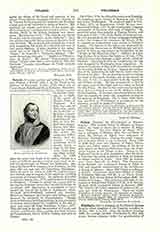

Pulaski, CASIMIR, patriot and soldier, b. at Winiary, Poland, March 4, 1748; d. on the Wasp, in the harbor of Savannah, October 11, 1779; eldest son of Count Joseph Pulaski and Maria Zislinska. His father, a noted jurist, reared him for the bar, and he received his military training, as a youth, in the guard of Charles, Duke of Courland. Pulaski was one of those who, under the leadership of his father, formed, February 29, 1768, the confederation of Bar, to free Poland from Russia. Driven into Moldavia he, returning, seized the monastery of Berdichev and for several weeks withstood with slender forces a siege by the Russians. Again finding refuge in Moldavia in 1769 after the arrest and death of his father, Pulaski in a series of brilliant marches overran and raised in revolt the greater part of Poland and Lithuania. Defeated by Suvaroff at Lomazy, near Wladowa, he fled with only ten men into the Carpathian Mountains. There he spent the winter of 1769-70, making forays into Poland, and in August, 1770, seized the fortified monastery of Czenstochowa. He gallantly defended it against a siege in January, 1771, and forced the Russians to withdraw. Though he joined his compatriots in driving the Russians across the Vistula, his failure to cooperate with Dumouriez is considered to have caused the loss of the battle of Landskron, where Suvaroff overwhelmingly defeated the patriots. Beaten at Cartenow near Leopol and failing to take Zamose, he returned to Czenstochowa. Though modern historians hold him guiltless, he was convicted of treason and outlawed for complicity in the plot to seize and carry off King Stanislaus, November 3, 1771. This plot lead to the open intervention of Prussia and Austria, and Pulaski, after a gallant but futile defense of Czenstochowa, fled in 1772 to Turkey, and later to France.
On October 17, 1776, he offered his services to Franklin, the American agent, landed at Boston in July, 1777, and joined Washington. He rendered signal service, September 4, 1777, at Brandywine Creek; he was commissioned September 15, 1777, by the Continental Congress commander of the horse with rank of brigadier. He saved the army from surprise at Warren Tavern, and took part, October 4, 1777, in the battle of Germantown. He was prominent in the Jersey campaign during the winter, but resigned his command, March 28, 1778, to organize an independent corps known as Pulaski’s Legion. The banner of the legion was purchased by him from the Moravians at Bethlehem and not presented to him, as represented by Longfellow in his “Hymn of the Moravian Nuns“. Ordered to Little Egg Harbor, New Jersey, the legion on October 15, 1778, suffered severe loss through a night attack, which he repulsed. Dissatisfied with his assignments, he was only dissuaded by Washington from resignation. He entered Charleston, May 8, 1779; he gallantly attacked the investing British on May 11. Against the inclination of the authorities he held the city until it was relieved on May 13. He rendered great services during the siege of Savannah, Georgia, and in the assault on the city, October 9, he commanded both the American and French cavalry. He was wounded by a shot in the upper part of the thigh, and was taken on board the brig Wasp. He died as the vessel was leaving the river and was buried at sea off St. Helena’s Island, South Carolina. It has been mistakenly held by some that his remains lie under the monument erected to his memory at Savannah. On May 11, 1910, there was unveiled at Washington a monument to his memory, erected by order of Congress.
JOHN G. EWING

